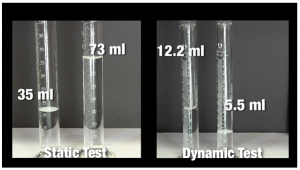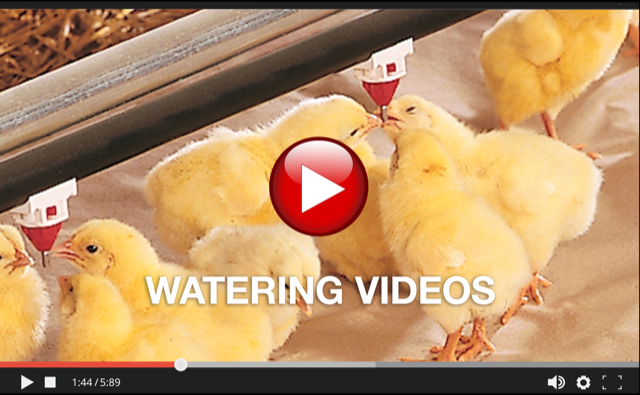Over the past decade there has been an attempt, encouraged by some in the poultry industry, to come up with easy-to-use universal management standards in an effort to achieve maximum bird performance. Click here for video related to this topic.
Central to this effort has been the use of “flow rates.” Flow rate has been promoted as a measure of how much water, over time, can be discharged from a nipple drinker given a particular water pressure setting. The idea was to establish a standard flow rate that would ensure birds get all the water they can drink through different kinds of drinkers. Based on research championed by a Mississippi State University poultry professor, optimal flow rate standards were set for birds as they grow. Advocates believed these standards would maximize water consumption for the bird as it matured.
 To determine the flow rate of a drinker, producers were told to hold the trigger pin up for one minute and then measure the amount of water discharged. Adjustments based on the amount of water collected (in milliliters/minute) could then be made for the bird’s age as determined by a formula. From the beginning, Ziggity Systems has found this procedure seriously flawed, and our ongoing discussion with producers and continuing analysis of actual results in the field over the years have only served to confirm this view, which is based on a close look at how birds actually drink.
To determine the flow rate of a drinker, producers were told to hold the trigger pin up for one minute and then measure the amount of water discharged. Adjustments based on the amount of water collected (in milliliters/minute) could then be made for the bird’s age as determined by a formula. From the beginning, Ziggity Systems has found this procedure seriously flawed, and our ongoing discussion with producers and continuing analysis of actual results in the field over the years have only served to confirm this view, which is based on a close look at how birds actually drink.
First, one of the underlying assumptions about flow rates appears to be that the more water that is discharged from the drinker, the more the birds will consume. This is not true. The reality is that the amount of water that a bird consumes during the drinking process is determined by the beak size, not the amount discharged from the drinker. And more water discharged from the drinker than can’t be held in the bird’s beak results in water spillage. So adjusting water pressure so that more water to be discharged with each peck does not necessarily mean the bird is consuming more water. What is more likely happening is that the litter is simply getting wetter from the spillage, which can create severe health challenges for the birds.
Second, the way birds actually drink is not by holding the trigger pin up for any length of time. They peck at the pin in diverse ways, from the side and from various other angles, with the drinker releasing a drop or drops of water at a time. Water does not flow out constantly when they drink. This is a much different dynamic than holding the trigger pin up and letting water flow out.
Questions raised about best management procedures
Today, producers are finding opportunities and challenges in many corners. From the burgeoning market in quality chicken paws to maintaining an extra healthy flock from start to finish, producers are called upon to use the best management practices available. In that regard, water pressure management is the single most important management procedure for poultry watering systems, and we believe producers need the best information available to help them achieve outstanding results. That is one reason Ziggity has started Poultry Watering U, and why we challenged this team to verify, in some objective way, the validity or non-validity of the flow rate standard.
Accordingly, Poultry U came up with an ingenious way to compare what we might call two different kinds of flow rates. What we will call the “Static Flow Rate” is, as mentioned, where the drinker pin is held up for a minute and the continuous, “static” flow of water from the drinker is measured.
Then there is what we call the “Dynamic Flow Rate” — the amount of water birds would discharge using their normal pecking habits. Our test shows how both of these rates track across different types of drinkers. The primary question we wanted to answer was: Is there a correlation between the Static Flow of a drinker and the more realistic Dynamic Flow using the same nipple type drinker? For instance, will drinkers with higher Static Flow also exhibit higher Dynamic Flow? And do drinkers with lower Static Flow also have correspondingly lower Dynamic Flow? In other words, while we consider Static Flow flawed in some ways, is there still some predictable correlation between Static and Dynamic Flow that would make Static Flow a useful measurement?
Testing flow rates
Answering these questions is difficult because there is no good way to measure how much water is discharged from a drinker when a bird drinks from it. However, the PWU technical team devised a solution by developing an automated test apparatus that approximates a bird’s drinking motion.
The apparatus tests two different drinkers at the same time, on the same drinker line, at the same water pressure, responding to the same triggering action. This apparatus simulates the birds’ beak pecking the trigger pin side to side with a constant motion, resulting in two activations of the trigger pin every second, producing a type of “Dynamic Flow” discharge. Water released in one minute is collected in a measuring vial for each drinker. By automating the pecking process in this manner it is possible to duplicate the same drinking conditions for different drinkers time after time in order to make accurate comparisons. The test team also set up a procedure on this apparatus to measure the Static Flow Rate of the same two drinkers.
The reason for developing this test apparatus is the presumption that a Dynamic Flow Rate test will provide a more realistic, and thus more accurate, measure of the water actually discharged when birds drink than does the Static Flow Rate test. If this premise is accepted, then we should look at the results of testing the same drinkers using both test methods to see if the Static Flow Rate test results do, in any way, help predict the water discharge of a drinker that is “dynamically” triggered, the way birds really drink. The PWU team conducted a number of comparison tests to gauge the Static and Dynamic Flow Rates of different drinkers. Click here for video of test.
No reliable correlations found
The results: In numerous tests, the water discharged using the Static Flow Rate method did not correlate to the amount of water discharged using the Dynamic Flow Rate method. The chart below gives one striking example from actual data:
| Drinker A | Drinker B | Results | |
| Static Flow Rate Test | 35 ml./min. | 73 ml./min. | Drinker B delivered 109% MORE water than Drinker A. |
| Dynamic Flow Rate Test | 12.2 ml./min. | 5.5 ml./min. | Drinker B delivered 45% LESS water than Drinker A. |
In the Static Flow Rate test, drinker B discharged considerably more water than drinker A at the same pressure (20 in./50 ml.) in one minute. In fact, it discharged more than twice the amount of water.
Logically, as drinker B discharged more than twice the amount of water for drinker A in the Static test, then for the Static Flow Rate test to have validity, drinker B should also discharge about twice as much water when using the more realistic Dynamic Flow Rate test. However, the results in the table above show the exact opposite actually happened.
Drinker B did not discharge more water than drinker A in the Dynamic Flow rate test. In fact, it discharged less than half of the water that was discharged by drinker A when using the Dynamic Flow rate method.
Numerous other test results showed similar variations among different types of drinkers, and as a whole prove there is no consistent correlation between Static Flow Rate and Dynamic Flow rate of nipple type drinkers. This makes sense because different drinkers release different amounts of water over time, depending on their design and construction. There is no one formula that works for all of them.
You can see more results at PoultrywateringU.com/tests. The test that resulted in the data-chart above is also shown, uncut, in a video at PoultrywateringU.com/testvideo.
Because Static Flow Rate tests and standards do not relate to how birds actually drink, we believe producers need to rely on other “best practices” to manage their system for maximum performance results. In fact, the PWU team has received plenty of feedback from producers who have been required to use the Static Flow Rate to manage their drinkers, with producers saying they have failed to get the desired results and have returned to more productive management systems.
Dynamic Flow Rates: Not a management tool either
The PWU Technical Team wants to be clear that the Dynamic Flow Rate test described here is still not a perfect way of testing bird water consumption because, in the real world, birds will peck the drinker in different ways that cannot be perfectly simulated. And, of course, the test apparatus used by PWU is not a device that can be used in the field to help establish optimal water pressure. All we are saying here is that results in the field and from these tests indicate that a static “flow rate” is not a helpful concept for poultry watering management.












